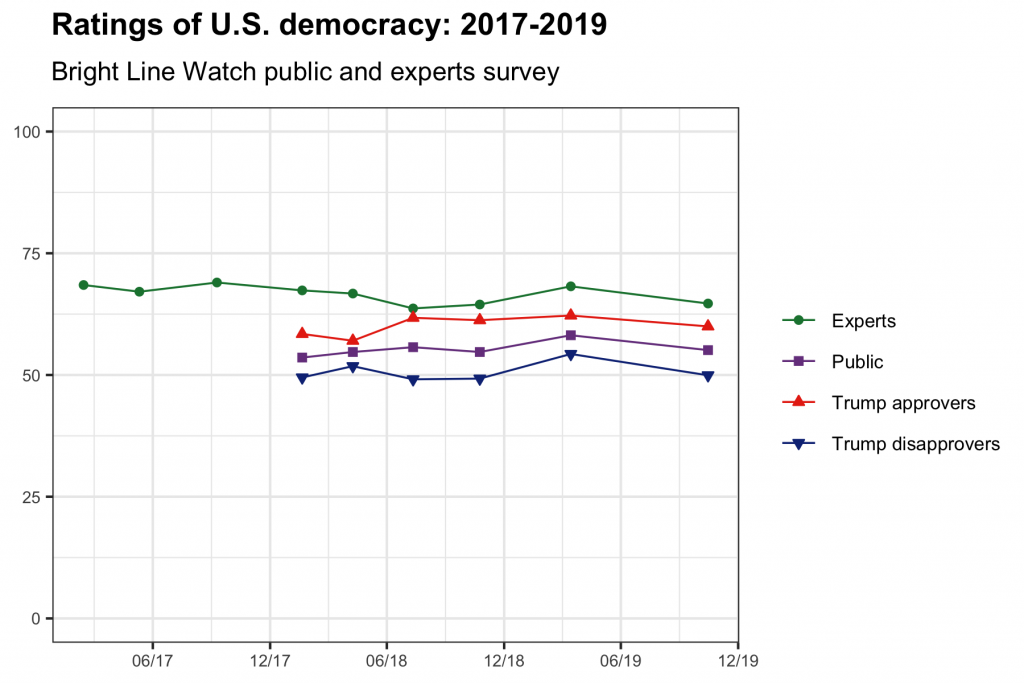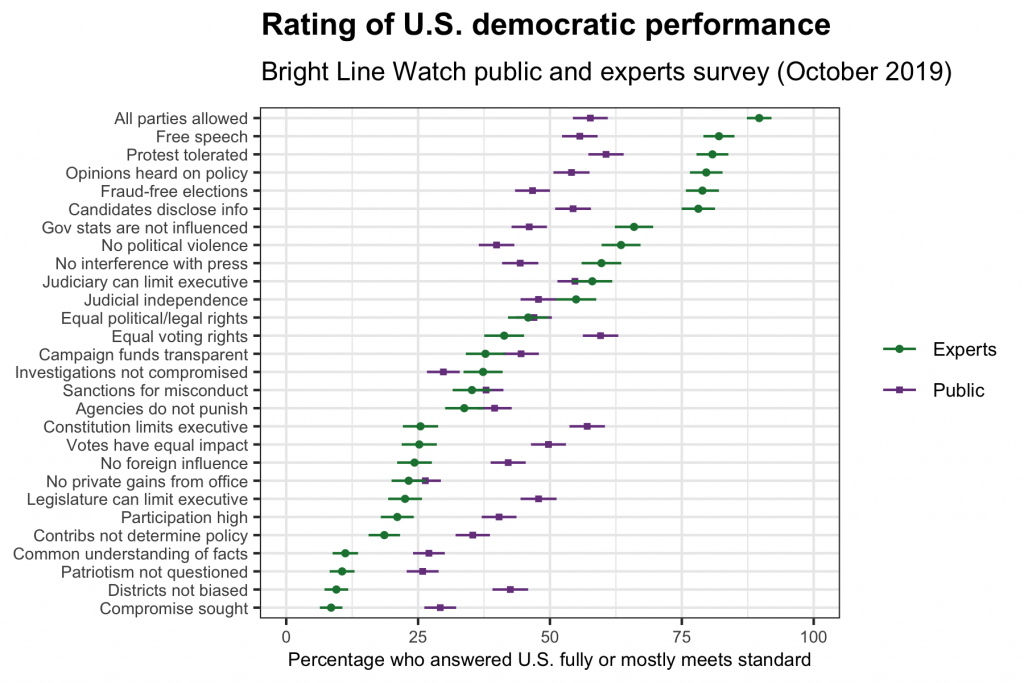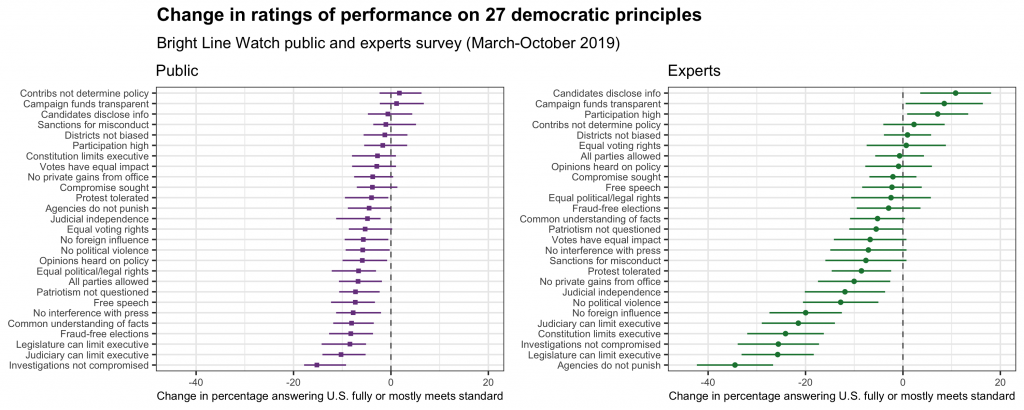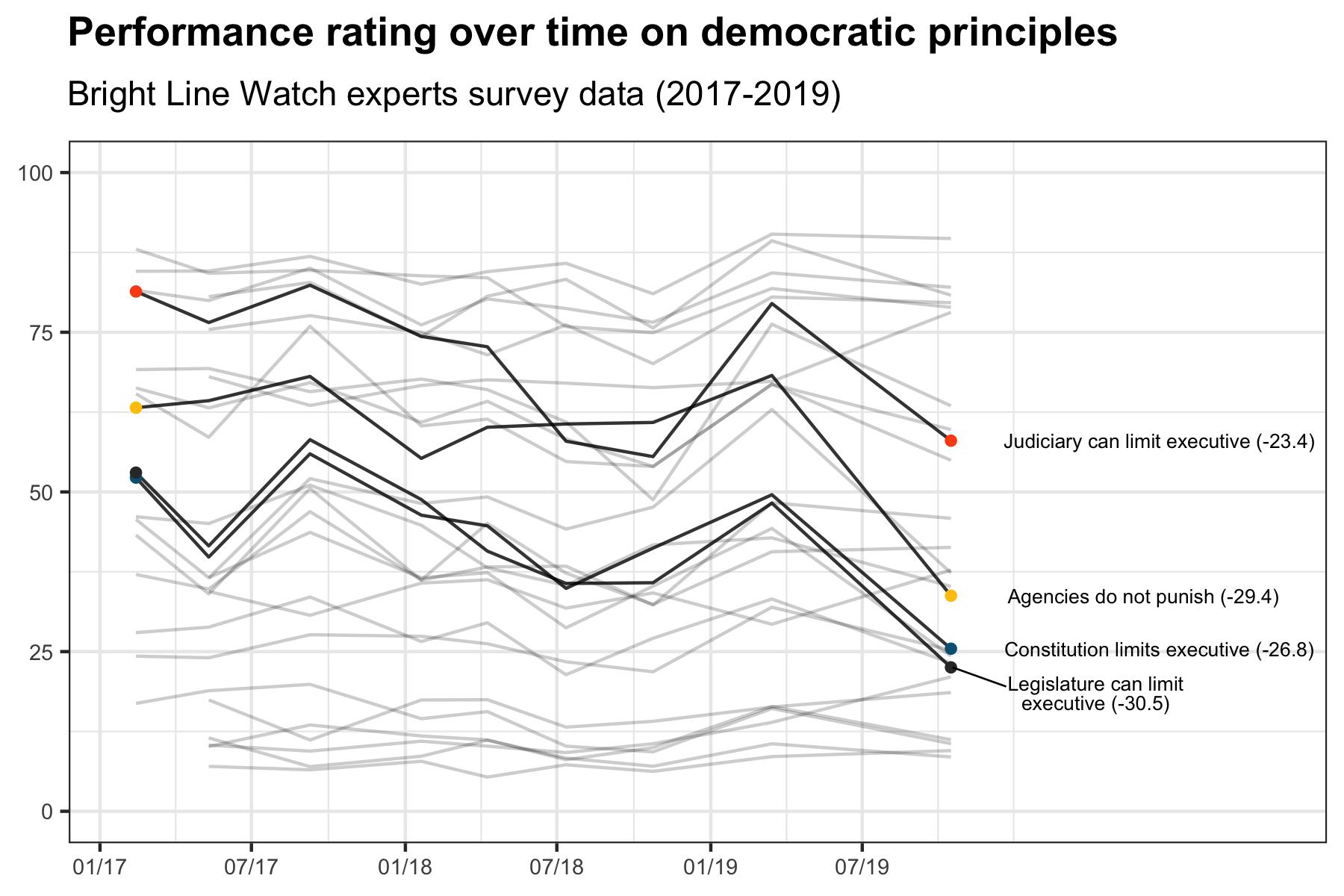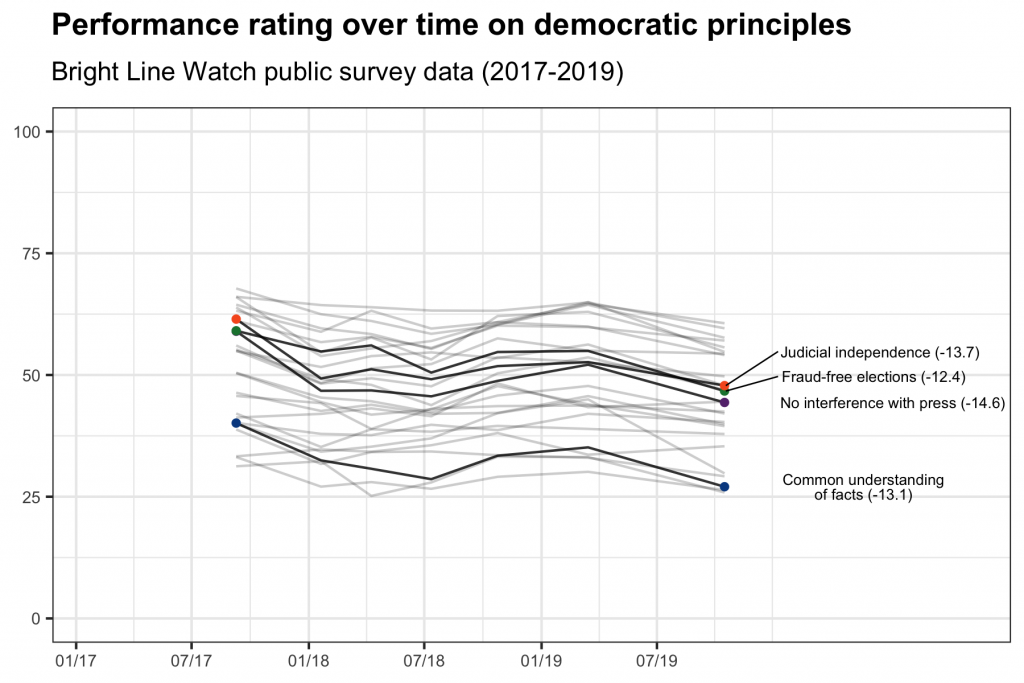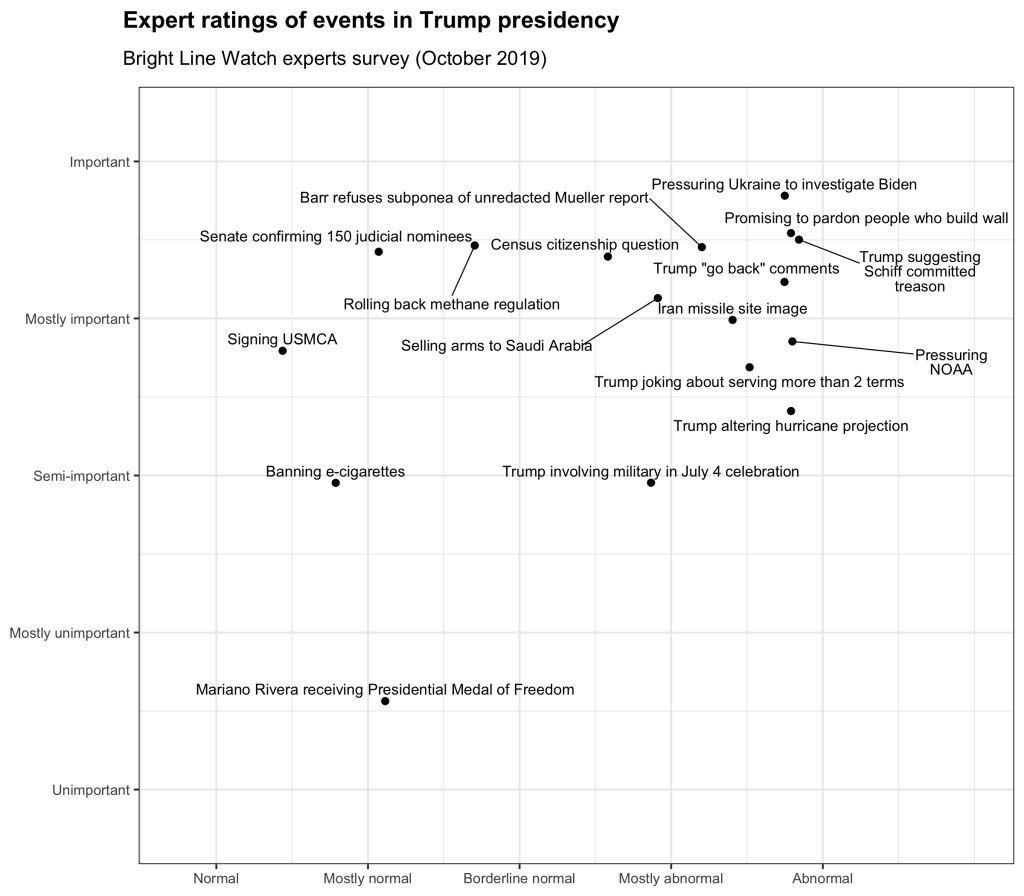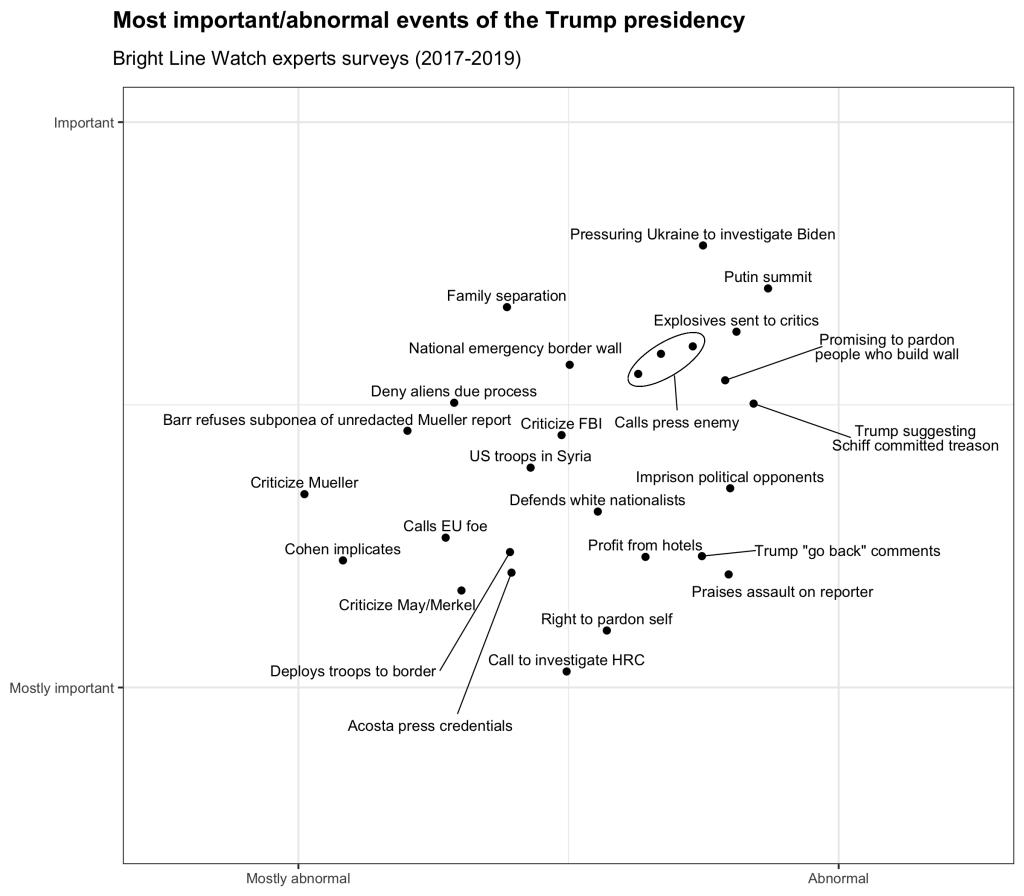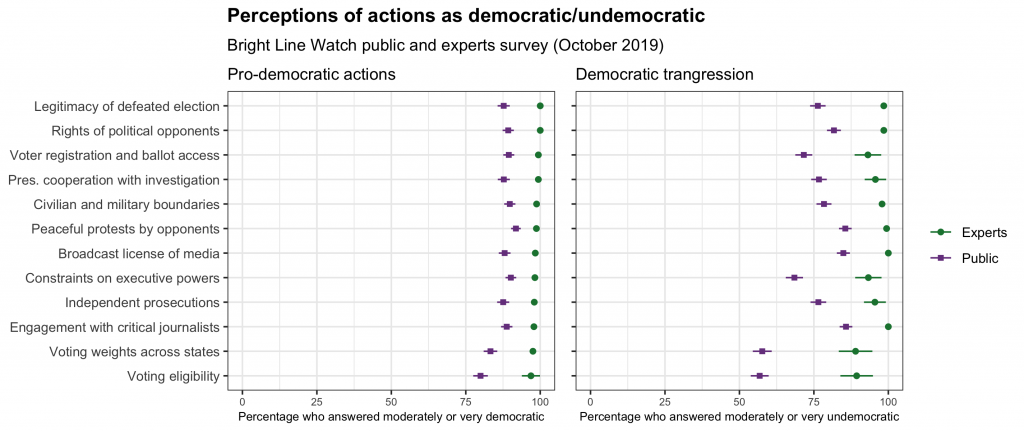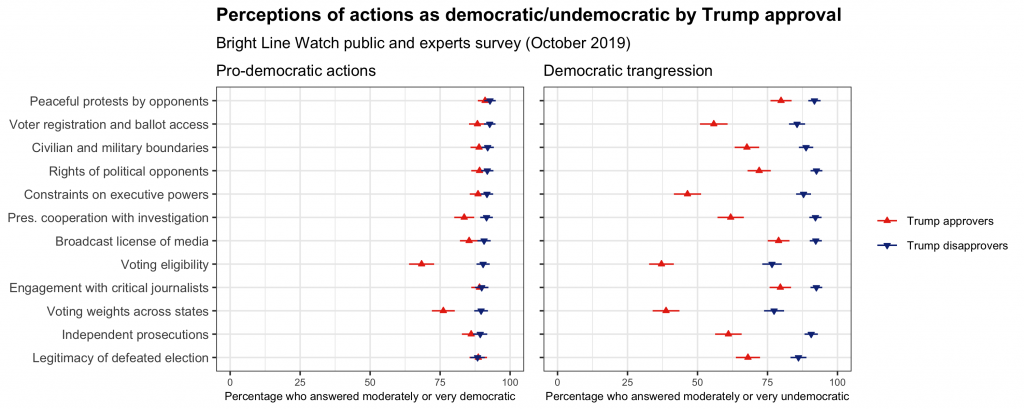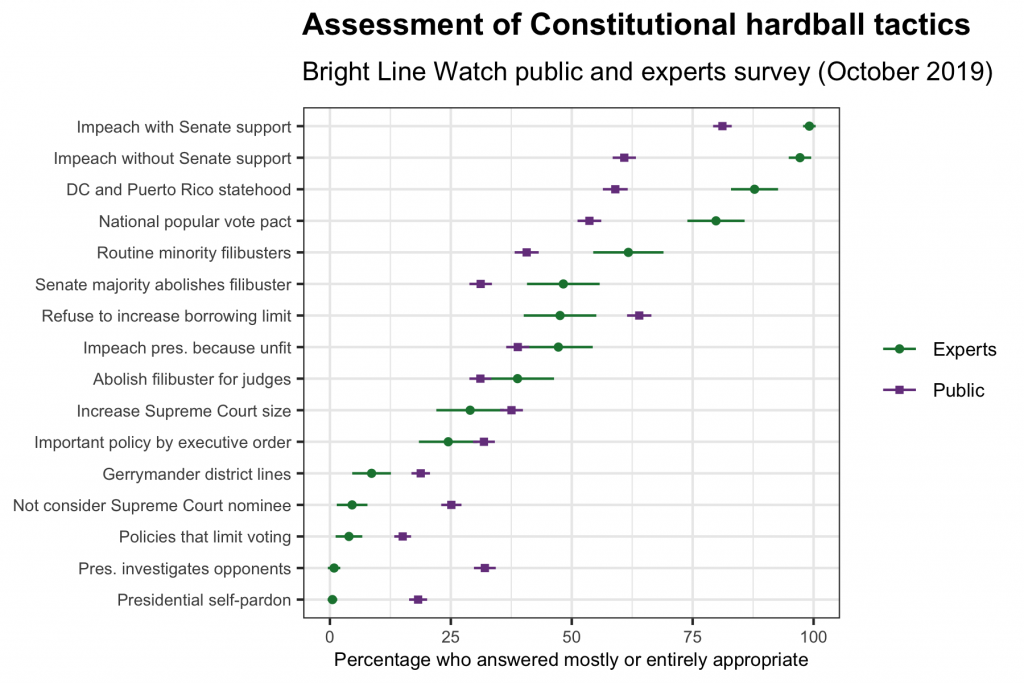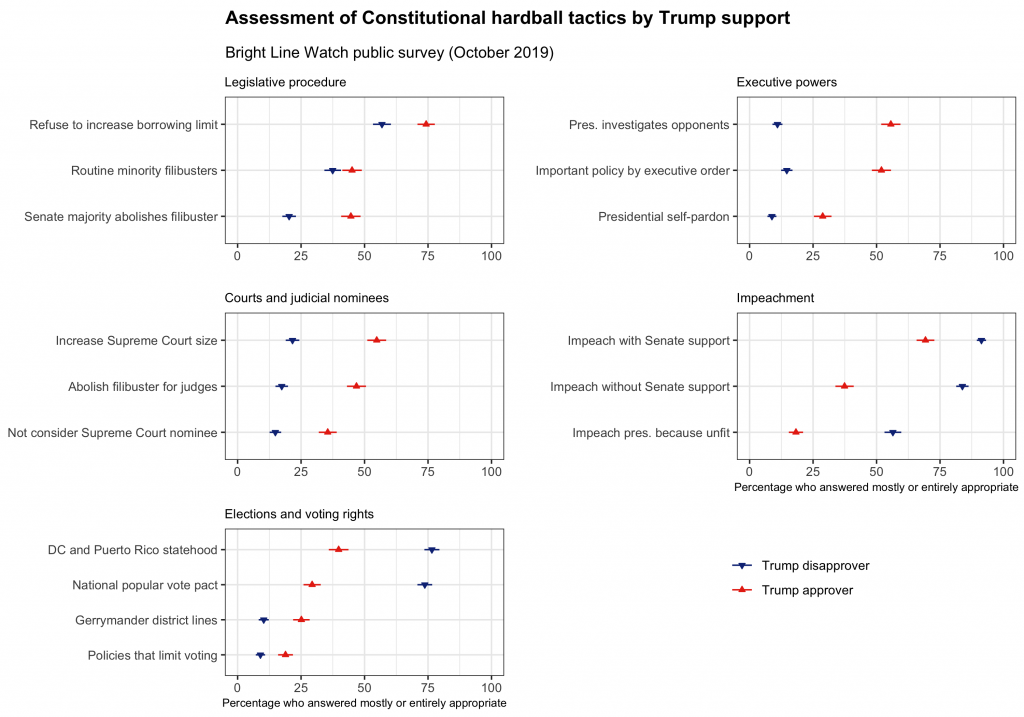From October 8–25, 2019, Bright Line Watch conducted its ninth survey of academic experts, and seventh of the general public, on the quality of democracy in the United States.[1] As in our previous surveys, we surveyed our respondents both on their overall evaluations of democratic performance and on over two dozen specific components of democracy.
The October surveys also provide insights into current challenges to American democracy that we have not explored previously. We presented both our public and expert respondents with a series of actions and behaviors and asked respondents to evaluate how democratic, or undemocratic, they regard them to be. We also polled respondents on a range of practices that have come to be known as “constitutional hardball” — political actors seeking advantage through actions that are within the formal rules of politics but which transgress existing norms and practices. In both cases, we find consensus among respondents (expert and public, and across the partisan divide) on some issues, but also evidence of deeply divided attitudes on whether certain actions are acceptable and appropriate.
Some key results from these surveys are:
-
Perceptions of the overall performance of American democracy remain stable among both experts and the public since we began surveying each group, but assessments on certain specific democratic principles have declined substantially, erasing perceived gains observed in the period after the 2018 midterm elections. Especially sharp declines were observed for beliefs that government agencies are not used to punish political opponents, the presence of effective limits on the authority of the executive, the independence of investigations into wrongdoing by public officials, and keeping U.S. elections free from foreign influence — all topics that closely relate to the current impeachment inquiry in the House of Representatives.
-
Experts again rate numerous recent events that have taken place during the Trump presidency as both important and abnormal. President Trump’s effort to pressure Ukraine into investigating Joe Biden, a potential 2020 election opponent, scores especially high on this dual metric (comparable to Trump’s summit with Vladimir Putin in Helsinki).
-
The public and expert consensus on actions that uphold democratic principles is strong — both groups (and especially experts) overwhelmingly rate actions like allowing peaceful protest as “democratic” rather than “undemocratic.” Moreover, most of the public rates actions that experts regard as transgressions against democracy, such as blocking peaceful protest, as “undemocratic”. The extent to which transgressions are viewed as undemocratic, however, is asymmetrical between supporters and opponents of President Trump. Both groups tend to rate such actions as undemocratic, but Trump supporters are less likely to do so than opponents, particularly for actions that President Trump has taken or ones that favor GOP interests.
-
Both experts and the public view some “constitutional hardball” tactics as appropriate but see others as inappropriate. For example, impeachment, admitting Puerto Rico and Washington, DC as states, and determining the presidency by national popular vote are typically viewed appropriate. Conversely, gerrymandering, disenfranchising partisan opponents, and presidential self-pardons are all widely regarded as inappropriate.
US democracy since 2017: Stability in overall performance
The figure below shows public and expert evaluations of the quality of U.S. democracy overall on a 100-point scale. Relative to our most recent survey, which was conducted in March 2019, we detect a slight decrease in ratings of U.S. democratic performance. In a broader sense, though, evaluations have generally been stable since we first started collecting these measures among both experts and the public. As we show below, however, measures of performance on specific democratic principles reveal important changes over time.
Performance on 28 democratic principles
We start with evaluations of 28 basic democratic principles and the degree to which they are currently upheld in the United States.[2] A full list of these principles is included in the appendix. To measure perceived democratic performance, we compare the percentage of respondents who rated the U.S. as “fully” or “mostly” meeting a given democratic standard with the percentage saying the U.S. only “partially meets” or “does not meet” it.
The figure below shows performance ratings from our academic experts (green markers) and the public sample (purple markers). Consistent with previous surveys, the range of performance evaluations is wider among the experts, which range from 9% to 90%, compared to the public, where the range of values runs only from 26% to 61%. Ratings in both groups are strongly correlated, however. Among both experts and the public, principles associated with freedom of expression (such as allowing all parties, freedom of speech, and peaceful protest) tend to be rated highest whereas those associated with norms of civility score at the bottom of the scale (such as seeking compromise and a common understanding of facts). Both groups also give low marks on elected officials not using public office for private gain. Finally, principles related to the quality of U.S. elections and institutions that hold government accountable fall between these extremes. In particular, a new item measuring perceived performance in producing nonpartisan statistics and data found more than 65% of experts but less than half of the public believes “Government statistics and data are produced by experts who are not influenced by political considerations.”
The public and experts disagree especially dramatically in two cases. U.S. performance on the principle that “All adult citizens have equal opportunity to vote” (60%) is rated rated second-highest among the public but only 13th among experts (41%). Similarly, 57% of the public believe that “Executive authority cannot be expanded beyond constitutional limits” but only 26% of experts share this view.
Compared to our most recent survey, which was conducted in March 2019, we find measurable declines on some democratic principles among our expert and public samples.
In the figure above, we see that among our expert sample, the largest decline in confidence were found for the principle that government agencies are not used to punish political opponents (-34 percentage points), which likely reflects the discovery of President Trump’s efforts to pressure the government of Ukraine to investigate Joe Biden. The other items on which the largest declines were observed are the presence of effective limits on the authority of the executive (by the judiciary, ‑21 points; from the Constitution, ‑24 points; or by the legislature, ‑26 points), the independence of investigations into wrongdoing by public officials (-26 points), and keeping U.S. elections free from foreign influence (-20 points). Assessments among the public declined less dramatically from March to October but in the same direction. The largest declines were concentrated among many of the same items, including the political independence of investigations, and the effectiveness of legislative and judicial checks on executive authority. These declines reflect longer-term trends, as illustrated in the next two figures, which show performance assessments across 27 democratic principles since we first began surveying each sample.
Among experts, the largest changes we have seen in perceived performance on our 27 democratic principles over time are all negative. The figure above shows the trajectory of changes for all 27 items while highlighting the four items in which the change from February 2017 to October 2019 is the largest — constraints on the executive from the Constitution (-27 percentage points), the legislature (-31 points), and the courts (-23 points) and government agencies not punishing their political opponents (-29 points). Some of these declines may be linked at least in part to recent revelations about the Trump administration’s efforts to use the State Department to pressure the Ukrainian government to investigate a political rival. Overall, perceived performance decreased by 10 percentage points or more for seven items; only two increased by the same margin.
Assessments among the public follow a similar pattern to those of experts, though the range and magnitude of changes are more compressed. The figure above shows the trend lines for all 27 principles on which we have surveyed the public since October 2017, highlighting the four items on which democratic performance assessments declined by 10 percentage points or more (none increased by this amount). We observe substantial declines in perceived judicial independence (-14 percentage points), freedom of the press from interference (-15 points), fraud-free elections (-12 points), and common understanding of facts (-13 points).
Assessment of recent events in the Trump presidency
Observers often worry that concerns over the Trump presidency lead to normal presidential actions being treated as aberrations or unimportant events being treated as consequential. We therefore also asked experts to rate a series of recent events from the Trump presidency for both how important and how (ab)normal they are. Their ratings of these events are depicted in the graph below, which allows us to identify which events are both important and truly abnormal. (The full statements associated with each item are included in the appendix to this report.)
As in prior surveys, experts rate a number of recent events as both important and abnormal. For instance, the Trump administration’s efforts to prevent experts at the National Oceanic and Atmospheric Association from contradicting the President was seen as abnormal and of greater importance than the alteration of a hurricane map with a marker. The three events that were seen as both highly important and especially abnormal, however, were the President accusing Adam Schiff, the Democratic member of Congress leading the impeachment inquiry, of treason, reportedly promising to pardon officials who broke the law in building his desired border wall, and pressuring the government of Ukraine to investigate Joe Biden.
In particular, our experts judge the Biden/Ukraine scandal to be the most important of the 93 Trump administration events they have rated in expert surveys conducted since August 2018. This may reflect judgments of the act itself as well as the role of the controversy in serving as the basis for the ongoing impeachment inquiry. The Biden/Ukraine scandal also rates as the tenth most abnormal event our experts have rated. To put the scandal in perspective, we plot the most important and abnormal events from the Trump presidency to date — ones that experts have rated between “Mostly abnormal” and “Abnormal” and between “Mostly important” and “Important” on average in Bright Line Watch surveys. As the graph shows, expert evaluations of the Ukraine/Biden scandal are most comparable to Trump’s Helsinki summit with Vladimir Putin.
What’s democratic? What’s not?
Our October 2019 surveys of experts and the public included a new battery developed jointly with Elisabeth Gidengil and Dietlind Stolle of McGill University measuring the extent of the consensus on whether twelve specific actions by political leaders are consistent with, or transgress, democratic practice. The actions fall into three broad categories: the conduct of elections, treatment of political opponents, and limits on executive authority. For each, we listed a positive action that is consistent with liberal democracy and a corresponding negative action describing a democratic transgression. For example, we measure civilian/military relations with the pro-democratic, “A president respects established boundaries between civilian and military authority” and the transgression, “A president compels active-duty military officers to promote his or her political agenda.” This design allows us to evaluate whether evaluations of these actions are consistently applied or whether the strength of the consensus about democratic practice varies between pro-democratic actions and transgressions.
To minimize the cognitive burden on respondents, each expert or member of the public was randomly assigned a subset of items that were either pro-democratic actions or transgressions of those norms. Respondents rated each as “Very democratic,” “Moderately democratic,” “Moderately undemocratic,” or “Very undemocratic.” (They could also answer “Not sure.”)
The full set of statements is listed below with items grouped by category. In each case, we list the pro-democratic action first and the transgressive action second.
Elections and voting
| Topic | Pro-democratic action | Transgression |
|---|---|---|
| Ballot access | Voter registration and ballot access rules allow all groups equal access regardless of race, ethnicity, or socioeconomic status. | Voter registration and ballot access rules place a greater burden on some racial, ethnic, and socioeconomic groups. |
| Equal votes | The votes of every citizen carry equal weight in elections for Congress regardless of the total population of their state. | The votes of citizens in states with small populations carry greater weight in elections for Congress than the votes of citizens in states with large populations. |
| Universal suffrage | Every citizen is allowed to vote regardless of where they were born. | Only native-born citizens are allowed to vote. |
Rights, protection, and freedom
| Topic | Pro-democratic action | Transgression |
|---|---|---|
| Media outlets | A government agency renews the broadcast licenses of media outlets even though they are critical of a president’s performance. | A government agency refuses to renew the broadcast licenses of media outlets that criticize a president’s performance. |
| Critical journalists | A president engages respectfully with journalists who are critical of his or her performance. | A president threatens to imprison journalists who are critical of his or her performance. |
| Peaceful protests | A government allows peaceful protests by its political opponents. | A government blocks peaceful protests by its political opponents. |
Institutions, accountability and rule of law
| Topic | Pro-democratic action | Transgression |
|---|---|---|
| Impartial prosecutions | Prosecutors decide whether to charge companies or individuals without interference from a president. | A president intervenes in prosecutors’ decisions about whether to charge companies or individuals. |
| Independent investigations | A government cooperates with an independent investigation into its own staff or Cabinet members. | A government blocks an independent investigation into its own staff or Cabinet members. |
| Civilian-military | A president respects established boundaries between civilian and military authority. | A president compels active-duty military officers to promote his or her political agenda. |
Norms and behavior
| Topic | Pro-democratic action | Trangression |
|---|---|---|
| Criticism | A president acknowledges the right of political opponents to criticize his or her leadership. | A president says political opponents who criticize his or her leadership should be investigated and imprisoned. |
| Emergency powers | A president respects institutional restrictions on his or her power. | A president uses emergency powers to circumvent institutional restrictions on his or her power. |
| Electoral legitimacy | A president endorses the legitimacy of an election in which he or she has been defeated. | A president attacks the legitimacy of an election in which he or she has been defeated. |
The figure below presents responses for both versions of each statement, showing the percentage who judge a pro-democratic action to be moderately or very democratic and the percentage who judge a corresponding transgression to be moderately or very undemocratic. The statements are presented in descending order based on responses to the pro-democratic action in the expert sample.
Encouragingly, the public largely regards pro-democratic actions as democratic and democratic transgressions as undemocratic, but several points warrant attention. First, for every statement, a larger share of the public rates a pro-democratic action as democratic than rates a transgression as undemocratic. This gap ranges from 3 percentage points on government treatment of critical journalists to 25 points for unequal voting weights between states. Second, the share of the public that regards each of the transgressions as undemocratic is far larger than the share of experts. Third, relative levels of undemocratic ratings across items are similar within the expert and public samples. The items that the public consistently rates as transgressions — the government blocking peaceful protests, blocking broadcast licenses, and threatening to imprison journalists — are also among those for which there was virtual unanimity among the experts. Items where larger minorities of the public did not rate a transgression as undemocratic tend to be those on which there is less unanimity among experts, notably on electoral rules, including restricting suffrage to the native born and affording different weights to the votes of citizens across states.
Perceptions of democratic practice among the public sample are often highly polarized by respondents’ partisanship or support for President Trump, however. The figure below breaks out assessments among the public by whether respondents support or oppose the president. The statements are presented in descending order of overall public respondents who consider a transgression to be undemocratic.
When we compare Trump approvers and disapprovers among the public, we find much more divided judgments of actions that transgress democratic norms and principles compared to those than affirm them.
President Trump’s supporters and his opponents largely share a consensus on pro-democratic actions. With the exception of granting equal rights to vote to all citizens and equal weight for votes across all states, each one is overwhelmingly regarded as democratic among both Americans who approve and disapprove of Trump’s performance in office.
But when we consider transgressions of the same democratic norms, the apparent consensus falls apart. On each item, Trump opponents regard the violation as undemocratic at far higher rates with gaps ranging from 12 to 42 percentage points. For example, 92% of Trump opponents regard the government blocking “an independent investigation into its own staff or Cabinet members” to be undemocratic, but only 62% of the president’s supporters share this judgment. Among Trump opponents, 82% regard it as undemocratic for the president to use emergency powers to circumvent restrictions on his or her power, but only 48% of Trump supporters agree. These results reinforce previous Bright Line Watch research showing far more cross-partisan consensus on positive democratic principles than on transgressions against democracy that would trigger broad public repudiation.
Constitutional hardball
The October 2019 survey also included a new set of questions intended to gauge support for a range of practices that have come to be known as “constitutional hardball.” The term was introduced by Mark Tushnet in a 2004 law review article describing strategies by which political actors seek to extend their political power and gain advantage by actions that are within the formal bounds of constitutional doctrine but that break with longstanding political practices. Debates over constitutional hardball have intensified in recent years, particularly as progressive critics have expressed outrage at perceived hardball tactics by President Trump and Senate Majority Leader Mitch McConnell and have urged Democratic politicians to embrace similar tactics.
Drawing from these debates, we identified political scenarios that might be regarded as constitutional hardball. The scenarios fall into five broad categories: Congress, executive power, impeachment, the courts, and elections and representation. The statements are listed below by category. Each survey respondent was asked, “Please indicate how appropriate or inappropriate you consider each scenario to be,” with response options: “Entirely appropriate,” “Mostly appropriate,” “Mostly inappropriate,” “Entirely inappropriate,” or “Not sure.”
Congress
- A majority party in either chamber of Congress refusing to raise the limit on the amount of money the U.S. government can legally borrow.
- The majority party in the Senate abolishing the filibuster rule so it can pass legislation without minority party support.
- The minority party in the Senate routinely using the filibuster rule to block legislation supported only by the majority party.
Executive power
- A President pardoning himself or herself.
- A President establishing important new government policy by executive order without passage of a law in Congress.
- A President directing the Department of Justice to open investigations into political opponents.
Impeachment
- A majority of the House of Representatives seeking to impeach a president because they believe he or she is unfit for office rather than because of specific evidence of high crimes and misdemeanors.
- A majority of the House of Representatives impeaching a president they believe has committed a high crime or misdemeanor even if the Senate does NOT support removal.
- A majority of the House of Representatives impeaching a president they believe has committed a high crime or misdemeanor when the Senate supports removal.
Courts
- The majority party in the Senate refusing to consider any nomination by a President to fill an open seat on the Supreme Court.
- The majority party in the Senate abolishing the filibuster rule so they can confirm judges without minority party support.
- A party that controls Congress and the presidency creating and filling new seats on the Supreme Court to change the partisan balance of power.
Elections and representation
- A party that controls both chambers of Congress granting statehood to Washington, D.C. and Puerto Rico.
State governments signing a pact to guarantee that the popular vote winner is elected president. - A state political party drawing Congressional districts that ensure it will receive a share of seats much larger than its share of votes.
- A state political party proposing measures that make it more difficult to vote, especially for members of the other party.
Most of the statements included in our list represent hardball scenarios that are independent from each other. However, we also administered a battery of questions that sought to assess the boundaries of support for impeachment. We asked whether respondents would support impeachment if the House majority simply regards the president as unfit for office; if a House majority believes the president committed a high crime or misdemeanor and does not anticipate a conviction in the Senate; and if a House majority believes the president committed a high crime or misdemeanor and anticipates a conviction in the Senate. These surveys were fielded soon after House Speaker Nancy Pelosi announced a formal impeachment inquiry into President Trump on September 24 after revelations of a whistleblower complaint about Trump’s July 25 phone call with Ukrainian President Volodymir Zelensky. Debates over the conditions that would justify impeachment were therefore prominent in the news media at the time.
The figure below shows the percentage of respondents who rated each item on the list as mostly or entirely appropriate. Green markers show responses among our expert sample and purple show responses from our public sample. The items are ranked in descending order of perceived appropriateness among the experts.
Perceptions of most constitutional hardball tactics were highly correlated between experts and the public, though expert judgments vary more widely by item (as with performance evaluations). For both groups, the highest rated item is impeachment when the House regards the president to have committed a high crime or misdemeanor and anticipates removal by the Senate. Under these conditions, impeachment is regarded as appropriate by nearly every expert and by 81% of the public. Absence of Senate support cuts the percentage of the public who regard impeachment as appropriate by 20 percentage points to 61% but barely affects expert ratings. Still, solid majorities in both groups believe impeachment is appropriate if the House believes the president committed a high crime or misdemeanor. By contrast, fewer than half believe impeachment is appropriate if the House merely regards the president as unfit for office (47% among experts and 39% among the public).
Other scenarios widely regarded as appropriate include granting statehood to Puerto Rico and the District of Columbia (88% among experts and 59% of the public) and an interstate compact to guarantee that the popular vote winner is elected president (80% and 54%, respectively). At the low end of the scale are scenarios that overwhelming majorities of both groups rate as inappropriate. These include the president issuing a pardon for himself or herself (1% among experts and 18% of the public regards this as appropriate, respectively), the refusal of the majority party in the Senate to consider confirming a president’s Supreme Court nominees (5% and 25%), and the president directing the Department of Justice to open investigations into political opponents (1% and 32%). There is also broad consensus against the appropriateness of two strategies associated with state-level politicians seeking advantage over their partisan adversaries: laws that make it harder for supporters of opposing parties to vote (4% of experts and 15% of the public) and redrawing district boundaries to their party’s advantage (9% and 19%). We find slightly greater tolerance for the president setting important policies by executive order (25% of experts and 32% of the public it regard it as appropriate, respectively), although substantial majorities among both groups regard the practice as inappropriate.
Two other prominent hardball strategies related to the courts are viewed skeptically by majorities in both respondent pools. One is the majority party in the Senate abolishing the filibuster rule so it can confirm judges without minority party support. This practice has a bipartisan history. In 2013, a Democratic Senate majority abolished the filibuster for federal court appointments below the Supreme Court. In 2017, a Republican majority then removed the filibuster for the nomination of Neil Gorsuch to the Court and maintained this policy for Brett Kavanaugh’s nomination the following year. However, abolishing the filibuster for federal court nominations is regarded as appropriate by only 39% of experts and 31% of the public. Both survey pools maintain similar circumspection toward expanding the size of the Supreme Court to alter its partisan composition, a prospect endorsed by only 29% of experts and 38% among the public despite prominent adherents in both the media and the presidential race.
Experts and the public tend to diverge on hardball tactics related to legislative obstruction. Consider, for example, the refusal by a party that controls a chamber of Congress to raise the federal debt limit, which prevents the government from borrowing to fund government operations. Stand-offs over the debt limit have led to government shutdowns lasting between two and five weeks in 1995–1996, in 2013, and in 2018–2019. This practice is regarded as appropriate by only a minority of experts (48%) but by a majority of the public (64%).
Experts and public also hold different views about the appropriateness of how the filibuster is used. 62% of experts regard it as appropriate for the minority party routinely to block majority party initiatives compared with just 41% among the public. However, more experts (47%) than members of the public (31%) approve majorities abolishing the filibuster altogether in order to pass legislation over the minority party’s opposition. The experts are more supportive than the public both of routine filibuster use and of abolishing the filibuster altogether.
Of course, constitutional hardball is consummate partisan politics. Scholarly and journalistic accounts trace its roots to increasing party polarization in American politics. With this in mind, the figure below breaks out levels of public support for our sixteen hardball scenarios by whether respondents support or oppose President Trump. The figure groups scenarios by category and, within each, lists tactics by descending order of overall support. We find wide variation in the degree to which assessments of constitutional hardball are polarized by party.
We find modest divergence in views of legislative tactics. Trump supporters are more inclined than opponents to abide debt limit showdowns, but majorities on both sides regard the strategy as appropriate. Majorities on both sides find routine use of the filibuster inappropriate, and the gap in opinion there is less than 8 percentage points. There is a greater divide over a Senate majority abolishing the filibuster, which only 20% of Trump opponents (predominantly Democrats, who are currently in the minority in that chamber) regard as appropriate.
View vary more widely on electoral scenarios. On the one hand, Trump supporters and opponents express near consensus that gerrymandering and policies designed to disenfranchise political opponents are inappropriate. By contrast, the chasm between Trump opponents and supporters on the admission of Washington DC and Puerto Rico as states (77% and 40%, respectively) and the National Popular Vote compact (74% and 30%) is vast. The latter two items might be expected to advantage Democrats by reducing existing Republican advantages in legislative representation and the Electoral College. However, one could say the same for state laws that increase barriers to voting and gerrymandering (in recent years), but neither generates similarly divergent opinions.
The most consistent divergence between Trump supporters and opponents is observed for items related to the use of executive authority and impeachment. Majorities of Trump supporters regard it as appropriate for the president to set important new policies by executive order or to direct the Justice Department to investigate political opponents, whereas only 11–15% of the president’s opponents share this view. In addition, three in ten Trump supporters accept the prospect of a presidential self-pardon compared with only one in ten opponents. There is also a wide gulf on whether viewing the President as unfit is an appropriate grounds for impeachment or whether impeachment is appropriate in the absence of Senate support. Majorities of Trump opponents view impeachment as appropriate in each case whereas the president’s supporters do not. However, that gap narrows considerably if the Senate would convict the President and remove him or her from office. Under those conditions, 70% of Trump supporters and 91% of opponents regard impeachment as appropriate.
We also find wide divergence in views of hardball tactics used to influence the courts, although the public is skeptical toward hardball tactics in this realm generally. More Trump supporters than opponents view the Senate refusing to consider a president’s Supreme Court nominees as appropriate. However, even though their party used this tactic to capture their current Court majority (via Senate Majority Leader Mitch McConnell’s audacious refusal to grant a hearing to President Obama’s nominee, Merrick Garland), only 36% of Trump supporters say such a move is appropriate. Similarly, we find a 29-point gap between pro- and anti-Trump respondents on abolishing the filibuster for judicial appointments, but even then less than half of Trump supporters regard the strategy as appropriate.
Finally, a narrow majority of pro-Trump respondents (55%) regard it acceptable to increase the size of the Supreme Court to alter its partisan balance, whereas only 22% of Trump opponents share this view. This last result is particularly striking in that President Trump’s two appointments secured a solid conservative majority on the Court, whereas the prominent voices currently advocating for court packing are progressives seeking to counter a perceived theft of the court. Our results suggest that broader public sentiment has not (yet) adjusted to the partisan tilt of this debate among elites.
Appendix
Bright Line Watch surveys on the state of America’s democracy, October 2019
From October 8–25, 2019, Bright Line Watch conducted its ninth survey on the state of democracy in the United States. We conducted previous surveys in February (Wave 1), May (Wave 2), and September (Wave 3) of 2017; in January (Wave 4), April (Wave 5), July (Wave 6), and October (Wave 7) of 2018; and in March of 2019 (Wave 8). Waves 1 and 2 targeted expert respondents only. Waves 3–9 have paired the expert survey with a representative survey of the American public.
Both the expert and public samples in Wave 9 responded to a battery of questions about democratic performance in the United States. Afterward, they were asked to evaluate the quality of American democracy overall on a 100-point scale. Experts were also asked to evaluate the quality of democracy in their state on the same 0–100 scale.
Expert respondents were then asked to respond to a second battery in which they were presented with a series of statements about current political events and asked to rate them on normalcy and importance (the list of events is provided below). Both the performance battery and the (ab)normality and /(un)importance battery are described in more detail above.
Respondents also rated pro-democratic actions or transgressions of those norms (in either case, a random subset of one type only) on a scale from “Very democratic” to “Very undemocratic” and/or potential constitutional hardball scenarios on a scale from “Entirely appropriate” to “Entirely inappropriate.” Experts were randomly assigned to either rate 9 pro-democratic actions or democratic transgressions (three randomly selected topics constituting nine items; direction randomly assigned) or to rate 9 constitutional hardball scenarios (three randomly selected topics constituting 9–10 items). The public rated twelve pro-democratic actions or democratic transgressions (type randomly assigned) and 12–13 constitutional hardball scenarios (four randomly selected topics). The order of the modules was randomized for public respondents.
The data from both the expert and public surveys are available here. All analyses of the public data from YouGov incorporate survey weights.
Performance battery
The foundation of Bright Line Watch’s surveys is a list of 28 statements expressing a range of democratic principles (the full list is provided below). Democracy is a multidimensional concept. Our goal is to provide a detailed set of measures of democratic values and of the quality of American democracy. We are also interested in the resilience of democracy and the nature of potential threats it faces. Based on the experiences of other countries that have experienced democratic setbacks, we recognize that democratic erosion is not necessarily an across-the-board phenomenon. Some facets of democracy may be undermined first while others remain intact, at least initially. The range of principles that we measure allows us to focus attention on variation in specific institutions and practices that, in combination, shape the overall performance of our democracy.
Bright Line Watch’s Wave 1 survey included 19 statements of democratic principles. Based on feedback from respondents and consultation with colleagues, we expanded that list to 29 statements in Wave 2. We then reduced that set to a set of 27 statements for the Wave 3 through Wave 8 surveys. 17 of those 27 statements were included in Wave 1, and all 27 were included in Wave 2. We added one statement to the list in Wave 9.
The full set of statements is presented below and grouped thematically for clarity. In the surveys, the principles were not categorized or labeled. Each respondent was shown a randomly selected subset of 14 statements and asked first to rate the importance of those statements and then to rate the performance of the United States on those dimensions.
28 statements of democratic principles
Elections
- Elections are conducted, ballots counted, and winners determined without pervasive fraud or manipulation
- Citizens have access to information about candidates that is relevant to how they would govern
- The geographic boundaries of electoral districts do not systematically advantage any particular political party
- Information about the sources of campaign funding is available to the public
- Public policy is not determined by large campaign contributions
- Elections are free from foreign influence
Voting
- All adult citizens have equal opportunity to vote
- All votes have equal impact on election outcomes
- Voter participation in elections is generally high
Rights
- All adult citizens enjoy the same legal and political rights
- Parties and candidates are not barred due to their political beliefs and ideologies
- Government protects individuals’ right to engage in unpopular speech or expression
- Government protects individuals’ right to engage in peaceful protest
- Citizens can make their opinions heard in open debate about policies that are under consideration
Protections
- Government does not interfere with journalists or news organizations
- Government effectively prevents private actors from engaging in politically-motivated violence or intimidation
- Government agencies are not used to monitor, attack, or punish political opponents
Accountability
- Government officials are legally sanctioned for misconduct
- Government officials do not use public office for private gain
- Law enforcement investigations of public officials or their associates are free from political influence or interference
- Government statistics and data are produced by experts who are not influenced by political considerations
Institutions
- Executive authority cannot be expanded beyond constitutional limits
- The legislature is able to effectively limit executive power
- The judiciary is able to effectively limit executive power
- The elected branches respect judicial independence
Discourse
- Even when there are disagreements about ideology or policy, political leaders generally share a common understanding of relevant facts
- Elected officials seek compromise with political opponents
- Political competition occurs without criticism of opponents’ loyalty or patriotism
To measure perceived democratic performance, the survey asked, “How well do the following statements describe the United States as of today?” Each respondent was then presented with 14 statements of principle, randomly drawn from the set above, and offered the following response options:
- The U.S. does not meet this standard
- The U.S. partly meets this standard
- The U.S. mostly meets this standard
- The U.S. fully meets this standard
- Not sure
The order in which statements were presented in the battery was randomized for each respondent so there should be no priming or ordering effects in how they were assessed.
Events
1. President Trump repeatedly joking that he might stay in office for more than two terms
2. Attorney General William Barr refusing to comply with a subpoena to provide the full unredacted report by special counsel Robert Mueller
3. The Trump administration attempting to add a citizenship question to the Census
4. President Trump telling four Democratic congresswomen to go back to their country
5. President Trump using emergency powers to sell arms to Saudi Arabia despite congressional opposition
6. President Trump tweeting a high-resolution image of an Iranian missile site
7. President Trump reportedly promising to pardon subordinates who break the law to build a border wall
8. President Trump signing the United States-Mexico-Canada Agreement (USMCA) along with the Canadian Prime Minister and Mexican President
9. The Trump administration announcing plans to roll back regulations on methane, a major greenhouse gas
10. The Trump administration pressuring the NOAA to reverse its statement contradicting the President on the threat Hurricane Dorian posed to Alabama
11. President Trump pressuring Ukraine to investigate Joe Biden
12. President Trump giving the Presidential Medal of Freedom to Mariano Rivera, a former pitcher for the New York Yankees
13. The Trump administration banning flavored e‑cigarettes from the U.S. market
14. President Trump holding a Fourth of July celebration in which he and the US military played a prominent role
15. The Senate confirming more than 150 of President Trump’s judicial nominees to the federal bench
16. President Trump or another administration official altering hurricane projections that were displayed during a public event
17. President Trump suggesting the chairman of the House Intelligence Committee should be prosecuted for treason
Notes
[1] Our public survey was distributed by YouGov, where we asked 2400 online respondents from October 8–18, 2019. Our experts survey was distributed by Luth research, where we solicited responses from 10,454 political scientists in the U.S. Between October 8–25, 752 (7.2%) responded to the invitation and 672 (6.4%) completed the survey.
[2] Previous Bright Line Watch surveys included 27 core principles. Beginning in this survey wave, we added a 28th statement: “Government statistics and data are produced by experts who are not influenced by political considerations.” We were prompted to include this statement by the Trump administration’s pressure on scientists from the National Oceanic and Atmospheric Association in September 2019 not to contradict erroneous statements the President had made about the projected path of a tropical storm. The direct consequences of that incident were minimal (the storm stayed at sea), but the general phenomenon of public agencies releasing slanted information that casts the government in a favorable light has a long history among authoritarian regimes. Degradations in U.S. government performance on this metric would thus be a potentially important sign of democratic erosion.

